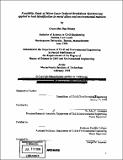Feasibility study of micro-laser induced breakdown spectroscopy applied to lead identification in metal alloys and environmental matrices
Author(s)
Hwang, Grace Mei-Hua, 1972-
DownloadFull printable version (37.46Mb)
Other Contributors
Massachusetts Institute of Technology. Dept. of Civil and Environmental Engineering.
Advisor
John T. Germaine.
Terms of use
Metadata
Show full item recordAbstract
This thesis presents a feasibility study that validates the pursuit of a field inorganic chemical analysis instrument. The instrument envisioned will have commercial marketability, and the study will enhance the understanding of fundamental science, and improve the practicable implementation of environmental policy and regulation. A novel, rapid, micro-Laser Induced Breakdown Spectroscopy ([mu]LIBS) technique for inorganic identification has been explored in metals, metal alloys, soil and paint pellets. This study employed a passively Q-switched infrared Microchip laser, in conjunction with a time-integrated miniature charged-couple device array spectrometer. During the period of this research, the Microchip laser was available only through MIT Lincoln Laboratory. The unique features of the Microchip Laser, (i.e., high peak power, short pulse width, miniaturization), make it a practical excitation source for chemical analysis. Its high pulse rate yields inherent spectra averaging. It's short pulse width and small focal size leads to a rapidly quenched µLIB plasma, which does not develop signal-dominating thermal radiation. Results from this study demonstrated a repeatable correlation between analyte signal strength at indicative emission wavelengths (i.e., lines) as a function of analyte concentration, for lead in metal alloys. A minimum detection limit of 0.07 % was observed for Lead in Leaded Copper. Quantitative detection limits of about 0.06 % for Lead was observed in Lead-Tin solders. All aforementioned detection limits were obtained without the use of any time-gating detectors. This technique was also used to demonstrate ionic lead and numerous other inorganic composition of soil and lead-in-paint. The work presented in this thesis demonstrates that [mu]LIBS is a practical means of detecting metal concentration in a variety of substrates. This thesis provides technical validation for the continued research to fully explore the applicability of the [mu]LIBS technique, as a multi-element inorganic detection tool for solid and aqueous environmental media.
Description
Thesis (S.M.)--Massachusetts Institute of Technology, Dept. of Civil and Environmental Engineering, 1998. "February 1998." Includes bibliographical references.
Date issued
1998Department
Massachusetts Institute of Technology. Department of Civil and Environmental EngineeringPublisher
Massachusetts Institute of Technology
Keywords
Civil and Environmental Engineering.